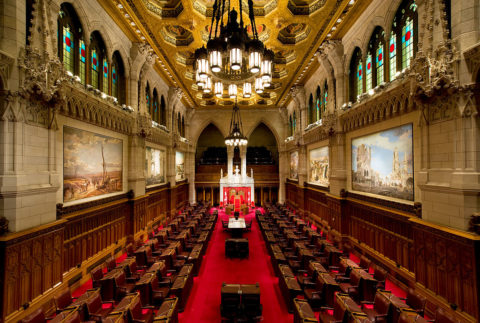Forces News
Published Feb 10, 2024HMS Victory is undergoing a massive restoration and conservation programme costing around £45m.
Lord Nelson’s flagship at the Battle of Trafalgar is being stripped right back and having all the rotten wood removed.
Forces News was given exclusive access to the ship, preserved for all to enjoy at the National Museum of the Royal Navy in Portsmouth, to see the progress that’s being made.
(more…)
May 18, 2024
HMS Victory: Returning Nelson’s flagship to her former glory
QotD: Academic research and the “phantom cite”
If you’ve done any academic work at all, in any field — scratch that, if you’ve done any competent, diligent work in any field — you’ve experienced the frustration of the “phantom cite”. This is where you see a startling assertion in Jones. You check his footnote — see Smith. You go pull Smith off the shelves, and his footnote says “see Williams”. Williams cites Parker, Parker cites Adams, Adams cites Rogers, until finally, you pull Rogers and … nothing. Not the “oh gosh, I’d have to travel to the British Museum to check this, and it’s in Medieval High Bulgarian anyway” kind of nothing, but the bald-ass assertion kind of nothing.
Happens all the time. There are a couple of reasons for this. Being as charitable as I possibly can, I’m going to call one “survivorship bias”. I’m sure you’ve seen this … Since, again, we’re being extremely charitable here, this isn’t actually a case of “just tell ’em what they want to hear”. I’ll illustrate from my own research experience. My dissertation asserts that General Ripper, commander of the 43rd Imaginary Infantry in Au Phuc Dup province, Republic of Vietnam, was convinced that the local provincial governor, Long Duc Dong, was a Communist infiltrator. Now, this is a 100% true fact, that Gen. Ripper believes Long Duc Dong is a Communist. Armies are awash in paperwork, and moreover Gen. Ripper was an obsessive letter-writer and diarist, so you can find hundreds if not thousands of citations stating it directly: “I, Gen. Ripper, believe that Long Duc Dong is a Communist”.
Which explains quite a bit about why Gen. Ripper made the decisions he did, which in turn is why this 100% indisputably true fact — that Gen. Ripper thought Long Duc Dong was a Communist — features so prominently in that study of the dynamics of command in the 43rd Imaginary Infantry.
The problem, though, is that some other historian comes along, looking at something very different — say, the effectiveness of anti-Communist propaganda in the IV Corps operational area — and comes across my dissertation. From this, he writes “So ineffective was the anti-Communist propaganda campaign that even the governor, Long Duc Dong, was strongly suspected of being a Communist infiltrator”. And from that, another historian, looking for the prevalence of pro-Communist sentiment, concludes that “despite the Americans’ best efforts, the extreme south of the RVN was so thoroughly indoctrinated that even the Governor, Long Duc Dong, was a Communist”.
Now, all of that is true except for the last bit. It is not, in fact, proven that Long Duc Dong was a Communist. Gen. Ripper sure thought he was. And Gen. Ripper continued to think so, even after the anti-Communist propaganda campaign, which means that the campaign indisputably failed in Long Duc Dong’s case — he carried on acting like enough of a commie to keep Gen. Ripper’s suspicions up. But thanks to the thicket of citations, it’s the last bit — the assertion that Long Duc Dong was, indisputably, a Communist — that has by far the most footnotes attached to it. Hell, the footnotes probably cite all the same things I did — the truckloads of letters and documents from Gen. Ripper saying “Damn that Long Duc Dong, he’s a Communist!!”
That’s because he lifted them straight from my dissertation, all impeccably footnoted — by which is meant, giving ME full credit — and do you see what I mean? None of the historians involved had any obvious axe to grind, no viewpoint to push. It’s just that everyone’s bibliography is a hundred pages long, and nobody has the time to read every page of every book in those hundred pages. Jones just skimmed Smith’s index, looking for names of commies. Smith did the same thing with my index, of course, in which he found “Dong, Long Duc, Communist sympathies of,” with dozens of page numbers referenced.
Severian, “‘Studies'”, Rotten Chestnuts, 2021-05-22.
May 17, 2024
“Once a mind is infected with Climate Change, bioweapons are just another kind of carbon credit”
Jo Nova presents evidence of a university professor — a vulcanologist — who perhaps has more sympathy for the volcanoes he studies than the human race:
Let’s just say, hypothetically, that someone wanted an excuse to reduce global population, or limit competing tribes and religions, there’s a scientific hat for that. Climate Change is the ultimate excuse for mass death — done in the nicest possible way and for the most honorable of reasons. But isn’t that what they all say: Jim Jones, the Branch Davidians, Heavens Gate — death makes the world a better place?
The cult that pretends it isn’t a cult sells itself as “science”. I mean, what the worst thing you can think of? Would that be one degree of warming, or the Black Death?
In Bill McQuire’s mind the catastrophe is not when billions of innocent people die.
One hundred years from now, what would our great grandchildren prefer: that the world was slightly cooler or they were never born at all? If you hate humans it’s a terrible dilemma …
Bill McGuire, vulcanologist, accidentally put his primal instincts in a tweet last weekend:
Thirty years of telling us that humans are bad has consequences. As Elon Musk said” They want a holocaust for humanity.” It turns out a televised diet of one-sided climate projection by mendicant B-Grade witchdoctors might be a dangerous thing for mental health. If only Bill McQuire had seen a skeptic on TV?
Predictably the McGuire tweet spread far, and got crushing replies so the Emeritus Professor deleted it, as all cowards do, yelling at us:
Lies my teacher taught me
A Peel District School Board teacher using the pseudonym “Igor Stravinsky” explains the sort of indoctrination high school students are receiving about First Nations and the development of Canada:
Previously in this series, I have discussed some of the things students are learning, and not learning, about Indigenous people in the Peel District School Board:
- Indigenous people are the true owners of the land; the rest of us are just settlers
- Indigenous people should be able to continue to practice their traditional ways while being provided all the amenities commensurate with living in a modern, first world country
- Indigenous people are victims, other Canadians are oppressors
- The disproportionately poor quality of life which characterizes the lives of many Indigenous people today is the result of past and current injustices by non-Indigenous people, chiefly the Indian Residential Schools
- Life was good for Indigenous people, who were wise and peaceful, before Europeans showed up
- The goal of the Europeans who arrived in Canada was the genocide of Indigenous people
- The settlers failed in their quest for genocide due to the courage and resilience of the Indigenous people
As I have demonstrated, all of the above is simplistic, misleading, or false.
Why teach students a false narrative?
The ahistorical Indigenous genocide narrative started out in academia where Grievance Studies (Indigenous Studies, Black Studies, Queer Studies, Fat Studies, etc.) have a massive presence. These post-modernist inspired programs, collectively referred to as “Critical Theory” have influenced all areas of academia and spread to Canadian institutions generally. Grievance studies programs can only exist so long as there are grievances, which necessitates re-writing history and putting people into oppositional groups of victims and oppressors. Academics had to either get on the bandwagon or keep their mouth shut if they disagreed with this new paradigm. Those who did not, such as Frances Widdowson, were attacked and paid a massive price for speaking freely about the lies on which grievance studies programs are based.
Left-leaning politicians have been keen to get on board with Critical Theory. It wins them support from the academics and well-meaning (but poorly informed) members of the public who want to be “on the right side of history”. Even conservative politicians tend to look the other way, seeing taking on the well-organized, well-funded, academia-based activists as an overall vote loser. After all, they can count on the conservative vote. To whom else can such voters turn? Consequently, school boards and the authors of school curricula are captured by Critical Theory and teachers are expected to tow the line. Anyone who doesn’t is said to be “causing harm” and faces harsh discipline.
Entrenchment of the Indigenous genocide narrative ensures ever increasing payments from Canadian taxpayers in the form of rent and compensation. The lion’s share of these payments go to the Grievance Industry Tzars- Corrupt Indigenous leaders and their non-Indigenous allies, with little trickling down to the average Indigenous person. That is why, in spite of the fact that an ever-increasing part of our federal budget is dedicated to payments to Indigenous groups (to reach 7.7% – $74.6 billion annually by 2026-27), many Indigenous people live in squalor on reserves without basic amenities like clean water, while many others live on the street in urban areas. How can this be happening when taxpayers are handing over more than $40 thousand per year per each Indigenous person?
Is it reasonable for people who want to live in remote areas engaged in low value hunting, gathering, and horticulture activities, declining to integrate into the modern Canadian socio-economic system, to expect 21st century amenities and services paid for by other Canadians? If non-Indigenous people balk at funding this economically unviable mode of existence, does that make us guilty of racism or genocide? That is the impression kids in school are left with after the “education” they receive on the matter.
Canada Post is in deep, deep trouble
I was vaguely aware that Canada Post has been in financial difficulties for a while, but I had no idea things were quite this dire:
You’d better believe that the Canada Post Corporation is in very deep trouble. Here’s how they phrased it in their 2023 annual report:
Canada Post’s financial situation is unsustainable.
“Unsustainable”. Well that doesn’t sound good. Think they’re just putting on a show to carve out a better negotiating position? Well, besides for the fact that they’re not currently negotiating with anyone, the numbers do bear out the concern:
For 2023, the Corporation recorded a loss before tax of $748 million, compared to a loss before tax of $548 million in 2022. From 2018 to 2023, Canada Post lost $3 billion before taxes. Without changes and new operating parameters to address our challenges, we forecast larger and increasingly unsustainable losses in future years.
In other words, it’s madly-off-in-all-directions panic time.
Hey! You know I can hear your condescending sniff: “I’m sure this is just a temporary disruption. They’ll figure out how to fix the leak and get themselves back on the road like always. They’re too big to fail.”
Yeah … not this time. The competition from digital communications (i.e., the internet), FedEx, and UPS isn’t going anywhere. Letter delivery nosedived from nearly 5.5 billion pieces in 2006 to just 2.2 billion in 2022. And vague references to “major strategic changes to transform our information technology model” don’t sound much like magic bullets for reversing the decline.
But Canada Post’s labour and pension costs sure are marching bravely forward. In fact, if it wasn’t for Parliamentary relief in the form of Canada Post Corporation Pension Plan Funding Regulations, the Corporation would have had to pay $354 million into the pension plan in 2023 alone. But that $354 million — plus whatever additional amounts show up in 2024 and besides the $998 million in existing general debt — are still liabilities that’ll eventually need paying.
Deviled Bones – The History of Hot Wings
Tasting History with Max Miller
Published Feb 6, 2024[Information from the Tasting History page for this video]
Chicken wings tossed in a spicy, complex sauce featuring mushroom ketchup.
The history of hot wings goes much further back than 1964 in Buffalo, New York, as a Google search might have you believe. Deviled bones were a way to use up undesirable chicken wings for centuries before that, calling for leftover cooked joints that still had some meat on them (the bones), and flavorful spices (deviled).
If you’re not a lover of spicy things, like me, then the 1/4 teaspoon of cayenne is plenty. That said, feel free to adjust the amounts of any of the spices to suit your taste. I was afraid that the mustard would be overpowering, but it isn’t. The flavor is complex and full of umami thanks to the mushroom ketchup. This is an easy recipe to do some prep work the day before, as the wings would have originally been leftovers.
Devilled Bones
Take the bones of any remaining joint or poultry, which has still some meat on, which cut across slightly, and then make a mixture of mustard, salt, cayenne, and pepper, and one teaspoonful of mushroom ketchup to two of mustard; rub the bones well with this, and broil rather brownish.
— A Shilling Cookery for the People by Alexis Soyer, 1854.
May 16, 2024
The replication crisis and the steady decline in social trust
Theodore Dalrymple on the depressing unreliability — and sometimes outright fraudulence — of far too high a proportion of what gets published in scientific journals:
Until quite recently — I cannot put an exact date on it — I assumed that everything published in scientific journals was, if not true, at least not deliberately untrue. Scientists might make mistakes, but they did not cheat, plagiarise, falsify, or make up their results. For many years as I opened a medical journal, the possibility simply that it contained fraud did not occur to me. Cases such as those of the Piltdown Man, a hoax in which bone fragments found in the Piltdown gravel pit were claimed to be those of the missing link between ape and man, were famous because they were dramatic but above all because they were rare, or assumed to be such.
Such naivety is no longer possible: instances of dishonesty have become much more frequent, or at least much more publicised. Whether the real incidence of scientific fraud has increased is difficult to say. There is probably no way to estimate the incidence of such fraud in the past by which a proper comparison can be made.
There are, of course, good reasons why scientific fraud should have increased. The number of practising scientists has exploded; they are in fierce competition with one another; their careers depend to a large extent on their productivity as measured by publication. The difference between what is ethical and unethical has blurred. They cite themselves, they recycle their work, they pay for publication, they attach their names to pieces of work they have played no part in performing and whose reports they have not even read, and so forth. As new algorithms are developed to measure their performance, they find new ways to play the game or to deceive. And all this is not even counting commercial pressures.
Furthermore, the general level of trust in society has declined. Are our politicians worse than they used to be, as it seems to everyone above a certain age, or is it that we simply know more about them because the channels of communication are so much wider? At any rate, trust in authority of most kinds has declined. Where once we were inclined to say, “It must be true because I read it in a newspaper”, we are now inclined to say, “It must be untrue because I read it in a newspaper”.
Quite often now I look at a blog called Retraction Watch which, since 2010, has been devoted to tracing and encouraging retraction of flawed scientific papers, often flawed for discreditable reasons. Such reasons are various and include research performed on subjects who have not given proper consent. This is not the same as saying that the results of such research are false, however, and raises the question of whether it is ethical to cite results that have been obtained unethically. Whether it is or not, we have all benefited enormously from past research that would now be considered unethical.
One common problem with research is its reproducibility, or lack of it. This is particularly severe in the case of psychology, but it is common in medicine too.
The Canadian Senate is an anti-democratic fossil … that might totally frustrate a future Conservative government
Tristin Hopper considers the constitutional weirdness of Canada’s upper house, an appointed body that has the power to block a popularly elected House of Commons:

“In the east wing of the Centre Block is the Senate chamber, in which are the thrones for the [King and Queen], or for the federal viceroy and his or her consort, and from which either the sovereign or the governor general gives the Speech from the Throne and grants Royal Assent to bills passed by parliament. The senators themselves sit in the chamber, arranged so that those belonging to the governing party are to the right of the Speaker of the Senate and the opposition to the speaker’s left. The overall colour in the Senate chamber is red, seen in the upholstery, carpeting, and draperies, and reflecting the colour scheme of the House of Lords in the United Kingdom; red was a more royal colour, associated with the Crown and hereditary peers. Capping the room is a gilt ceiling with deep octagonal coffers, each filled with heraldic symbols, including maple leafs, fleur-de-lis, lions rampant, clàrsach, Welsh Dragons, and lions passant. On the east and west walls of the chamber are eight murals depicting scenes from the First World War; painted in between 1916 and 1920”
Photo and description by Saffron Blaze via Wikimedia Commons.
By the anticipated date of the 2025 federal election, only 10 to 15 members of the 105-seat Senate will be either Conservative or Conservative appointees. The rest will be Liberal appointees. As of this writing, 70 senators have been personally appointed by Trudeau, and he’ll likely have the opportunity to appoint another 12 before his term ends.
What this means is that no matter how strong the mandate of any future Conservative government, the Tory caucus will face a Liberal supermajority in the Senate with the power to gut or block any legislation sent their way.
“If a majority of the Senate chose to block or severely delay a Conservative government’s legislative agenda, it would plunge the country into a constitutional crisis the likes of which we have not seen in more than a century,” reads an analysis published Tuesday in The Hub.
Constitutional scholars Howard Anglin and Ray Pennings envisioned a potential nightmare scenario in which the Senate casts themselves as “resisting” a Conservative government. Given that senators are all permanently appointed until their mandatory retirement at age 75, it would take at least 10 years until a Conservative government could rack up enough Senate appointments to overcome the Liberal-appointed majority.
“Canadian politics would grind to the kind of impasse that is only broken by the kind of extraordinary force whose political and social repercussions are unpredictable,” they wrote.
The piece even makes a passing reference to 1849, when mobs burned down Canada’s pre-Confederation parliament.
The prospect of an all-powerful Senate able to block the mandate of an elected government is a legislative situation almost entirely unique to Canada.
New Zealand abolished its Senate and is now governed by a unicameral legislature. Australia and the United States both employ term-limited elected senates. The U.K. House of Lords – on which the Canadian Senate is closely modelled – is severely constrained in how far it can check the actions of the House of Commons.
But in Canada, the Senate essentially retains the power of a second House of Commons; it can do whatever it wants to legislation that has passed the House of Commons, including spike it entirely.
Search and Destroy: Vietnam War Tactics 1965-1967
Real Time History
Published Jan 5, 2024In 1965, tens of thousands of US troops are heading for war in Vietnam. Backed up by B-52 bombers, helicopters and napalm, many expect the Viet Cong guerillas to crumble in the face of unstoppable US firepower. Instead, in the jungles and swamps of Vietnam, the Americans discover combat is an exhausting slog in which casualties are high and they rarely get to fire first.
(more…)
QotD: Modern parenting in open-concept houses
… our era does seem to be peculiarly marked by careless design. Few of the men who built middle-class versions of the Craftsman bungalow or Colonial Revival in the early twentieth century were trained architects, and they often adapted or simplified their designs to cut costs, and yet they somehow managed to get their proportions right. They might have used fewer columns than the more expensive examples of their styles, but what columns they did employ were the right shape, while today’s are liable to be too skinny (if Classically-inspired) or fat and stubby (if Craftsman). I won’t pretend I have an explanation for this — it seems a small aesthetic piece of a much broader societal failure, just one more case of chucking tradition out the window. Architect Léon Krier suggests that once the language of traditional design had been intentionally destroyed by architecture schools, it was very hard to recreate or rediscover because our new and exciting construction materials do not punish us for our errors the way wood, stone, and lime do. (“Even a genius,” he writes, “cannot build a lasting mistake out of nature’s materials.”)
But the real crime of most new construction isn’t the exterior details. It’s inside, and it’s walls. They’re missing.
Open floorplans are bad. They’re bad for entertaining and they’re bad for families. Sure, that photo looks great (if you’re allergic to color and texture) and the HGTV hosts love ’em, but imagine actually living in that room with children. Seriously, just try: how fast are the cushions coming off those couches? How fast are your neutrals drowned beneath colorful toys and backpacks? (Unless you’re inflicting the same sad beige color scheme on your children.) How much visual clutter can a room of that size accumulate, and how much help will a small child need just figuring out where to start tidying up?
How many times do you have to ask the monster truck vs. dinosaur battle by the fireplace to pipe down so you can talk to Daddy over here by the stove, for Pete’s sake?
There’s a school of American parenting that says every moment with your child should be spent intensively nurturing his or her precious individual development. At lunch, for instance, you should make eye contact with your ten-month-old and describe the texture and flavor of each food (perhaps in French!) while Baby carefully grinds it into her hair. Your child’s quiet drawing time will surely be enhanced by his mother hovering at his elbow: “Tell me about your picture, honey! Uh-huh, and how do we think the villagers feel about Gigantor devouring them? Gosh, you sure gave him some big teeth!” An open floorplan is a tremendous boon to this sort of parenting: your child is always visible, so you can always be engaged.
It is completely impossible to raise more than maybe two children this way.
I don’t know which way the causation goes — do parents who were already inclined to be a little more laid-back and hands-off find their lives have room for more kids, or does sheer number of children force you to alter your tactics? — but either way, small families and intensive parenting go together, and they live in an open-concept house with 1.64 children.
Walls and doors, on the other hand, are God’s greatest gift to large families. Of course it is wonderful to be together. It’s important to have spaces that will fit everyone. (We were very sad when it was no longer possible to pile everyone into a king-size bed, even with elbows.) But it’s just as important to be able to be apart: because your little brother is practicing piano while you’re trying to do algebra, or a blanket fort combines poorly with an elaborate board game, or just because LEGO spaceships are a noisy business and your mother is reading to your sisters. (Or, God forbid, reading a book herself.)
Because at the end of the day, houses are just the stage where life happens. This isn’t to say that the stage-dressing is irrelevant — there is real worth and value to surrounding ourselves with order and beauty, and understanding how your house or neighborhood got to be that way can illuminate new things about the world. But ultimately, what matters most is how you make it a home.
Jane Psmith, “REVIEW: A Field Guide to American Houses, by Virginia Savage McAlester”, Mr. and Mrs. Psmith’s Bookshelf, 2023-12-05.
May 15, 2024
Canada’s Minister of National Defence says new submarines are “inevitable”
Bill Blair regrets earlier comments that some read as weakening the government’s already feeble commitment to re-equipping the Royal Canadian Navy’s submarine branch:

HMCS Victoria, one of the four submarines currently in service with the Royal Canadian Navy. She was originally commisioned into the Royal navy as HMS Unseen in 1991 and re-commissioned as HMCS Victoria in 2000.
Image via Wikimedia Commons.
Bill Blair, the federal defence minister, made a rare admission of Liberal fallibility in Washington on Monday when he said he regrets using the word “explore” when talking about renewing Canada’s submarine fleet.
Ottawa’s recent defence policy update said the government will “explore options for renewing and expanding the submarine fleet”, a form of words that was criticized for lacking urgency.
“It’s certainly not my intention to be wishy-washy. What I’ve tried to articulate very, very clearly and strongly in the document is, we know we have to replace our submarine fleet, and we’re going to do that,” Blair said.
Replacing the four Victoria-class subs is necessary, he said. “It is, I might suggest, inevitable.”
That is absolutely the case, if Canada is committed to maintaining its submarine capability. The Victoria-class subs date back to the late 1980s and are due to be taken out of service at the end of the 2030s.
Submarines are seen as a crucial defence against incursion by hostile powers, as the polar ice melts and opens up northern waterways. The Northwest Passage is forecast to be the most efficient shipping route between Asia and Europe by 2050.
But Blair admits “there is a lot of work to do”, not least convincing his cabinet colleagues of the “business case for the capability”.
“One of the greatest challenges of being a defence minister is to secure funding and the second one is actually spending it”, he said on Monday.
He gave a sense of the struggles around the cabinet table last month in a speech in Ottawa, where he admitted: “I had to sort of keep on pushing my issue forward about the importance and the need to invest in defence”. He made it sound as if he was a lone voice in the wilderness.
[…]
Retired captain Norman Jolin recently wrote an analysis for the Naval Association of Canada that noted if Canada wants to maintain submarine capability, it needs to place a contract with a proven builder by 2027 at the latest. He said the lack of domestic submarine-building capacity means there is neither the time nor resources to even think about a made-in-Canada solution.
The typical procurement process takes 18 years to get from cabinet approval to delivery, which would mean if an order was placed tomorrow, we wouldn’t get new subs until 2042.
Based on that timeline, “it is clear that the decision to replace the submarines is considerably overdue,” Jolin wrote.
There’s little chance that this will move closer to completion during the remaining life of the current government, with an election due before the end of 2025, and Blair is already on the record emphasizing how little the Liberals would relish spending any money on military equipment even in good economic times. Oddly, the fact that there are no domestic shipyards currently capable of building submarines may be a positive — building the RCN’s ships in Canadian yards always means that each ship costs much more than if the hull is built in a foreign shipyard. Canada doesn’t have the facilities and trained workforce to build naval vessels, so every time a new class of ships is needed, the cost of building/refurbishing the shipyards and hiring and training-from-scratch a new workforce balloons the total cost of the program.
Disintermediation Now! “Even the gatekeepers are sick of dealing with gatekeepers”
Ted Gioia on the trend for even people at the top of the distribution chain trying to find ways to get around the distribution chain they inhabit:

The Emoji Movie premiere at the Fox Theatre, Westwood Village, 23 July 2017.
Photo by Kristofer Gonzalez-DeWhitt via Wikimedia Commons.
A few weeks ago, 35 of the biggest names in Hollywood collaborated on a business venture. Can you guess what it is?
I’ll help by providing a list of the participants. Here they are in alphabetical order, to avoid wounding any of the huge egos involved:
J.J. Abrams, Judd Apatow, Damien Chazelle, Chris Columbus, Ryan Coogler, Bradley Cooper, Alfonso Cuarón, Jonathan Dayton, Guillermo del Toro, Valerie Faris, Hannah Fidell, Alejandro González Iñárritu, James Gunn, Sian Heder, Rian Johnson, Gil Kenan, Karyn Kusama, Justin Lin, Phil Lord, David Lowery, Christopher McQuarrie, Chris Miller, Christopher Nolan, Alexander Payne, Todd Phillips, Gina Prince-Bythewood, Jason Reitman, Jay Roach, Seth Rogen, Emma Seligman, Brad Silberling, Steven Spielberg, Emma Thomas, Denis Villeneuve, Lulu Wang and Chloé Zhao.
What are these movie titans up to?
Maybe they want to make a film together? Or perhaps they’re thinking bigger — planning to launch their own production company or even a movie studio?
Nope. They weren’t thinking big. They were thinking small — very small.
These heavy hitters got together to buy a 93-year-old building.
They now own the Westwood Village theater at 945 Boxton near the UCLA campus. I went there to see films when I was in high school and it was old even back then. At some point it stopped being old, and became historic and vintage. (Maybe if I live long enough this will happen to me too.)
But these 35 investors aren’t just interested in preserving a quaint old building. They want to own a place where they can show quality movies to a flesh-and-blood audience without anybody getting in their way.
We’ve reached a point where even the people in power at the top of the industry want to bypass the system. Even the gatekeepers are sick of dealing with gatekeepers.
That’s how bad it’s gotten.
At least one of Queen Victoria’s PMs thought her “very wilful and whimsical, like a spoilt child”
In The Critic, Jonathan Parry reviews Queen Victoria and Her Prime Ministers: A Personal History by Anne Somerset:
In 1875, Queen Victoria sent Benjamin Disraeli a long and querulous letter “about vivisection, which she insists upon my stopping, as well as the theft of ladies’ jewels”. Similar heated and impracticable demands might arrive on his prime ministerial desk several times a day. He was not alone in thinking her “very wilful and whimsical, like a spoilt child”.
After the Conservative ministry’s defeat at the 1892 general election, Victoria complained it was “a defect in our much famed constitution to have to part with an admirable government like Lord Salisbury’s for no question of any importance or any reason, merely on account of the number of votes”.
Victoria’s outbursts to, and about, her ten prime ministers over the 64 years of her reign provide the meat of Anne Somerset’s book. Most of her letters were extremely forthright; some were endearing; not a few seem demented. She found disturbances to her comfort or routine particularly intolerable, such as ministerial crises which erupted in Ascot week or during one of her pregnancies.
Somerset’s approach is exhaustive and chronological. Gluttons for Victorian political history will probably enjoy it; she writes well and authoritatively, though could be more concise. Over nearly 600 pages, the effect of this torrent of royal complaint is overwhelming. It’s easy to see why a shaken Bismarck stuttered, “Mein Gott! That was a woman!” after his only audience with Victoria in 1888.
The book is presented as a “personal history” of the exchanges between her and her premiers. Most readers will sympathise with the men who had to manage her tactfully; many will wonder why they put up with it.
Yet they put up with it because of the principles at stake, which a “personal” account cannot bring out properly. Beneath the excitable phrases and endless underlining, Victoria’s correspondence doggedly promoted a coherent policy. She fought to maintain the authority of the Crown within the constitution, seeing it as essential for effective government. Her worry was that popular pressure would destabilise politics, through extra-parliamentary agitation but also through parliamentary organisation. So she was very suspicious of political parties, which she saw as factional agencies whose populist demands would disrupt the constitutional status quo.
Politically she remained a Hanoverian monarch: she believed the Crown should manage parliament through ministers chosen for their competence, loyalty and patriotism, not their commitment to popular causes. She even tried (unsuccessfully) to glean information on internal cabinet arguments so she could play her ministers off against each other, a trick used by her Georgian predecessors until the cabinet managed to assert collective responsibility in the 1820s.













